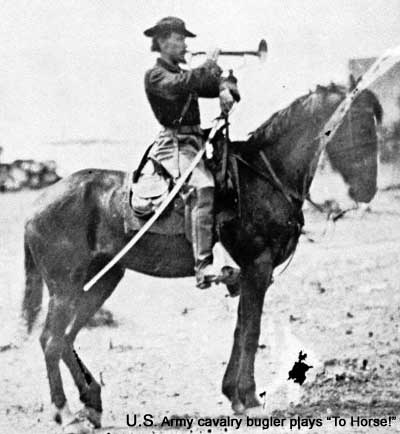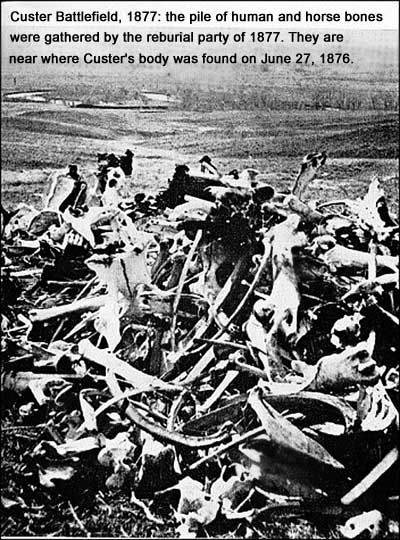|
|||||||
Bruce Brown's 100 Voices... A.F. Mulford's Story of the 1877
TRUMPETER MULFORD'S DESCRIPTION OF THE BATTLEFIELD IN 1877 ON SCOUT TO LITTLE BIG HORN Accompany Officers to Battlefield Where Custer and All His Force Were Killed Skeletons Strewn Over Scene of Battle
Some say that the distance from Tongue River, near the mountains, to the battlefield, does not exceed twenty-five miles; others place the estimate at thirty and none over thirty-five -- but we, after two long and hard days' ride from the head of the Little Horn in the mountains, a point nearer than Tongue River, at present General Miles's headquarters, carefully compute the distance to be at least forty-five miles. Beginning with the noble table-land upon which we stood, the ground gradually and gently fell towards the river, straightening out as level as a floor, and with both sides clearly defined by the sparsely shaded streams and the bluffs. Beyond the water appeared the rugged embankment, extending from the south (where Reno held his force while Custer and his command were struggling in "the jaws of death,") to the limit of vision on the north, standing perpendicular, save an occasional gap through which some trickling stream contributed its mite to the general volume of the Little Horn, or through which entrance to the fords are made, and through which we must ride if we would gain the other side. Still farther back, towards the Rosebud, the silent timberless, sandy Wolf Mountains loomed high, casting a mild and pleasing shadow over the landscape, while at the other extremity of the valley the gradual divides, rich with verdure and brighthued with full blown flowers, completed as beautiful a scene as the eye of an artist ever rested on, or the hand of a master ever transferred to canvas. At last, after a weary march, and not without the many little incidents which go to liven up, and sometimes to still further depress the drooping spirits of man and beast, we arrived at and entered the site of the old Indian village, hard by which General Custer and his men were trapped and slaughtered. This camping place was about four miles long, a half-mile wide, and located by the river side, upon a depressed table-land with a thin growth of timber, which at one time extended all over the bottom, but the felling of the trees by the squaws to secure the bark for food for ponies during the winters, had left the central portion of the strip almost barren. At the southern side, we passed through a dense, bushy grove, covering three or four acres, where the squaws and papooses were concealed when Custer approached, and until the Cavalry were securely trapped. Beyond this the ground presented a strange spectacle. Teepee and lodge poles were as thick as they could stand, while all about camp equipage and hides were scattered in confusion. An outstanding feature was the great quantities of leggins lying about, and the only explanation is, that the Indians discarded them for articles of clothing taken from the dead soldiers. Farther down we saw six burial scaffolds, and on the ground beneath them were the bones of as many Indians, the skull of one of them having been pierced by and still containing a rifle bullet. [Here is Seventh Cavalry survivor William Edgerley's account of what Low Dog told him concerning the dead the Sioux left behind. Here is Arikara scout Young Hawk's description of finding the corpse of former Sioux scout, Chat-ka.] It was nearly dark when we reached the lower ford, about half-way through the abandoned Indian village, where we camped for the night, wet, cold, hungry and greatly fatigued. Supper was quickly prepared, and after eating and taking a short smoke, we spread our wet blankets on the ground, and all turned in for the night; but not to sleep, for coyotes and wolves kept up their horrid din, as though angry at being deprived of their accustomed nightly hunt for scraps of muscle and flesh on bones scattered about. We had been lying down some time, when a yell rent the air, and Jack Healey sprang to his feet shouting "snakes!" Jack, while nearly asleep, had felt a cold, slimy something crawl over his face, and then followed the warning cry of "snakes!" We were soon on our feet, quickly replenished the dying fire, and with sabers in hand began to hunt for the unwelcome intruders. No snakes were found, but we found lizards, hundreds of the slimy green things, and the slaughter continued until the last one found was dead. Then we tried our blankets again but dread of another attack by the repusive things did not allow us to fall asleep. Soon another man felt one of the reptiles crawling over him, and then all arose and there was another slaughter of lizards. Sleep was out of the question. So we lay and sat around until morning dawned. After a hasty breakfast we passed on over the battlefield, where a little over one year ago, General George A. Custer and three hundred brave troopers of the Seventh Cavalry, while in the line of duty, were massacred by between three and four thousand Indian warriors under the immediate command of Sitting Bull. Not one of the hostiles having part in that massacre has ever been called to account for the awful deed. Worse than that, some of these very same savages are now fed and supported by the government they fought against, and are the forced associates and companions of members of the Seventh Cavalry! The bodies of our dead had never been properly buried. All these months had passed, yet the little band whose brave deeds of heroism will ever remain a matter of history, have not received decent burial. Their bones, divested of clothing by the heartless and brutal savages, and of flesh by wolves and other animals, lie bleaching on the ground where they fell, a sad result of the failure of Major Reno to give expected support. [Note: Mulford has this completely wrong; the truth was the exact opposite. Every observer (Marcus Reno, Frederick Benteen, William Edgerly, William Slaper, the Findings of the Marcus Reno Court of Inquiry, etc.) agreed that Custer promised he would support Reno's charge, not the other way around. Why Custer never provided the support he promised Reno is one of the central enigmas of the Battle of the Little Bighorn. See Who Killed Custer -- The Eye-Witness Answer for more info.] Two days after the battle a small detachment was sent to bury the bodies, but not one was given proper interment -- graves were shallow, and dirt thrown but sparsely over bodies was soon washed away by rains or dug away by scavenger animals and birds. Crossing the Little Horn, or Custer River as it is now called, to the east side, a well-defined trail leads up the gradual slope a quarter of a mile in length. The ground is covered with sage brush, coarse grass, prickly pears, and is destitute of rocks or timber. We reach the summit, and see a ravine with gentle sloping sides, near a half-mile in length-and free from rocks, timber, or anything that could furnish shelter. Nearby are the uncovered remains of eighteen men, in six piles, with a piece of tepee pole sticking in the ground at each pile. Upon one of these "tombstones" hung a white sombrero, relic of a member of the Seventh Cavalry, with two bullet holes through it, and a long cut as if made with an axe; and near by we found an axe, with a dark stain on the rusty blade, it having undoubtedly been used by the squaws in their frenzied mutilation of the wounded and dead of the Custer command. Near here were the carcasses of two horses; to the north, a few yards away, were heaps of bones so mixed that it was not possible to count the number of persons represented. A little farther on, and another heap containing the bones of three men appear beside the skeleton of a horse, evidently killed to be used as a breastwork. A heavy trail runs along the crest of the divide, which separates the river from the ravine, and it was thickly strewn with whitened bones, rotting equipments and clothing.
This elevation of the battlefield is but a little above the divide of which it is the terminus, and is, apparently, a commanding position. But the enemy were too powerful for the small body of troops who were there. On top of the hill where Custer was killed, we saw the skeletons of four men and horses, among the latter being the skeleton of the horse that Custer rode. [Mulford is incorrect on this point. Sioux and Cheyenne eye-witness accounts of the battle agree that Custer's fast sorrel horse with four white socks -- ironically named, Victory -- was captured during the battle, either by Noisy Walking or Little Buffalo.] We returned to Tongue River, with the picture of that field of death vividly impressed on our minds, and wondering if Custer and his men would have perished had Reno tried to fight his way to Custer's rescue. Trumpeter Martin [Pvt. John Martin AKA Giovani Martini] says Reno could have got there; and Trumpeter Martin knows, as he is the man Custer sent back to ask Reno to hurry to his assistance. [Note: again, Mulford manages to be inaccurate on several levels at the same time. First of all, it was not Reno's role to support Custer, but rather the reverse. Secondly, there is no hint of any charge or expectation in any of John Martin's eye-witness accounts of the battle (1908, 1910, 1922) that Reno could have -- or should have -- abandoned his defensive position in the bluffs to try to "rescue" Custer. Reno had lost nearly half his command -- dead or missing -- in the space of fifteen minutes and was out-numbered at least ten-to-one by Custer's own pre-battle intelligence estimate. He was in no position to rescue anyone, and in fact he came very close to meeting the same fate as his commanding officer: White Man Runs Him said the Sioux would have killed Reno and all his men if Frederick Benteen hadn't arrived at the crucial moment.] The Custer Myth: A Source Book of Custerania, written and compiled by Colonel W.A. Graham, The Stackpole Co., Harrisburg, PA 1953, p 378 - 379
This 1878 eye-witness account of the first Little Bighorn Battlefield reburial detail is full of errors (no, the Little Bighorn River is not now called the Custer River) and aquiver (pun intended) with Custer worship, but it paints a vivid picture of the battlefield 14 months after the fight that drives home the magnitude of the U.S. Army's defeat with somber power. Here is Edward S. Godfrey's account of the first burial of the dead. Here's White Cow Bull's explanation why he stopped dismembering a dead soldier, possibly Custer himself. |
|
||||||




 ABOUT fourteen months after "
ABOUT fourteen months after "








